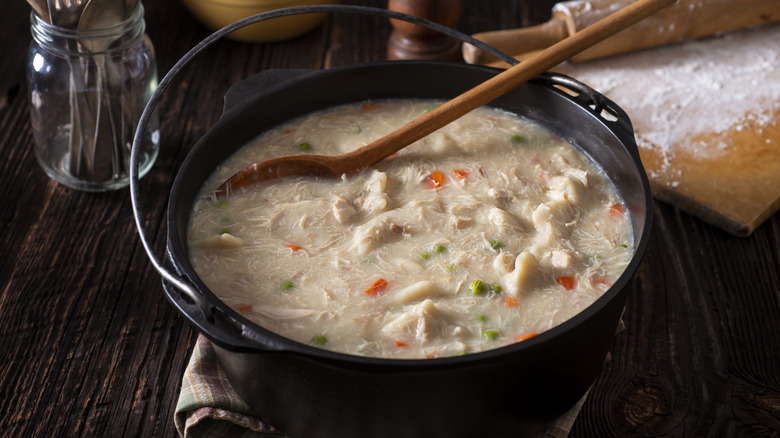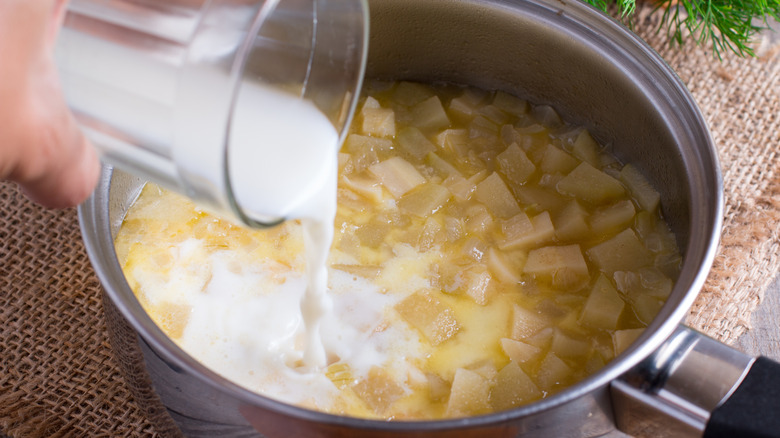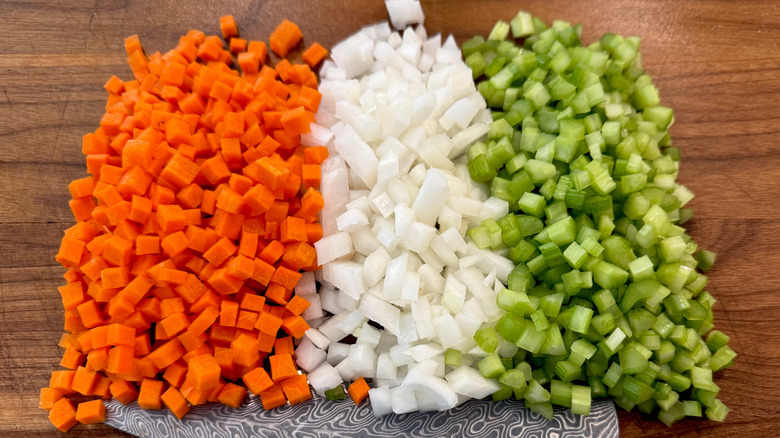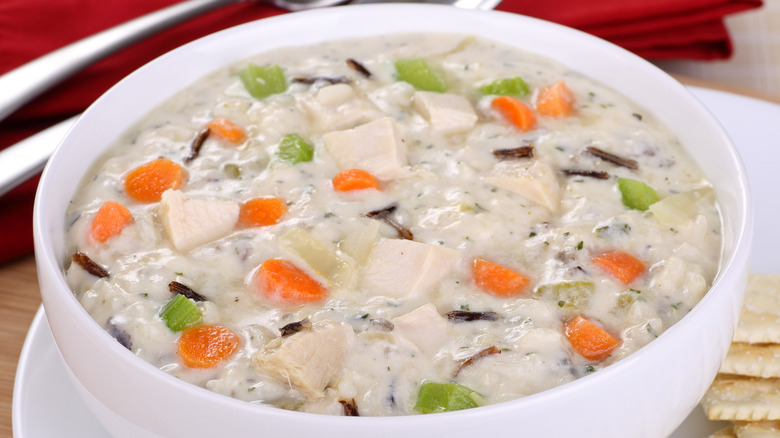5 Easy Ways To Upgrade Canned Cream Of Chicken Soup
In the world of comfort food, you may have noticed that many recipes require a can of condensed soup. Cream of chicken soup, whether it's Campbell's or a store brand, is the canned ingredient you need for the juiciest fried chicken and the creamiest chicken and dumplings. However, if you've ever eaten this soup as-is — not just as an ingredient — you probably weren't satisfied. Cream of chicken soup tends to be bland on its own, even when you follow the label's instructions. Fortunately, implementing a few upgrades can turn this canned staple into a more gourmet experience.
Most of the time, it's important to follow package instructions when you're preparing a meal, but sometimes cooking requires improvisation. To upgrade canned cream of chicken soup, dilute it with milk to avoid an overly watery consistency. You can also make it heartier by adding more protein, incorporating vegetables, and mixing in grains like pasta or rice. And, just like elevating standard chicken soup, don't be afraid to sprinkle in some fresh herbs and your favorite seasonings.
Dilute it with milk instead of water
Canned cream of chicken soup is condensed, meaning most of its water has been removed. It's very similar to canned evaporated milk, which can also make soup creamier because it's just milk minus about 60% of its water content. This evaporation gives it a smooth, gel-like consistency, so you have to thin it out with liquid for optimal flavor and texture.
The label on a Campbell's can provides instructions for preparing the soup with either 1 can of water, 1 can of milk, or ½ can of water and ½ can of milk. For the creamiest and richest soup, though, we recommend using only milk since water can make the consistency too thin. Milk does contain water, meaning it can loosen the soup's gelatinous texture, but it also adds fat to maintain creaminess.
Keep in mind that you don't have to add a full can of milk to the condensed soup, either — some home chefs find that this also makes it too watery. Instead, whisk in a little at a time and stop once the soup reaches your preferred consistency. Some people also bring the soup to a boil rather than just heating it; this provides thicker results because some of that added water content evaporates. Milk isn't even your only option. Consider adding a splash of half-and-half or heavy cream along with the milk for a silkier mouthfeel.
Add chunks of protein
After diluting your cream of chicken soup, you might wonder where all the chicken is. Campbell's, for instance, uses "tender chicken meat" in its condensed soup, but this mostly takes the form of tiny dried and shredded pieces. Plus, based on the nutrition label, there are only about 5 grams of protein in an entire can (or just 2 grams of protein per serving).
So, like with upgrading cream of mushroom soup, it only makes sense to add more protein when you want to eat cream of chicken soup as a meal. Cut off some chunks from a whole roasted bird or cooked breast and add them to your pot. You could even add shredded chicken out of a can if you don't already have leftovers in the fridge (or extra time to make some). In either case, browning the chicken in a pan first will give your soup even more flavor. If the meat is cold when you add it, just heat the soup long enough so that it warms all the way through.
Throw in some veggies
Two of the ingredients in our impossibly easy chicken pot pie recipe are canned cream of chicken soup and frozen mixed vegetables, so it only makes sense that adding veggies to your pot of soup will give it more substance. While the three vegetables of mirepoix — carrots, celery, and onions — offer a classic combination of aromatics used for many dishes, including soups, you can pretty much add any fresh or frozen vegetables you like, such as peas, creamed corn, or potatoes.
The trick to adding veggies is to use the right amount. If you add too much, your soup could turn out more stew-like. For a single can of cream of chicken soup, start with 1 cup of vegetables and add more to your preference. Some home chefs avoid adding broccoli, as it tends to fall apart, but adding it shortly before your soup is heated through can prevent that.
Timing is another important aspect of adding veggies to your soup. Fresh vegetables will need more time to soften and cook than frozen, as the latter are typically blanched before packaging. Try starting your soup by sautéing a fresh mirepoix in the pot until it starts to soften, then add your can of soup and milk. Since frozen veggies don't take long to thaw in a soup, they only need to heat for a few minutes. Also, consider dumping frozen veggies into a strainer first to sift out extra ice crystals that could dilute the dish further.
Make it heartier with pasta or rice
While introducing extra protein and vegetables into your canned cream of chicken soup will give it more substance, you can also do so by adding some pasta or rice. These ingredients are integral in countless recipes — like chicken, pasta, and vegetable casserole — and they'll definitely come in handy when you want to make a simple soup.
Pasta shape can impact the overall mouthfeel of your dish, but we recommend pairing spaghetti with cream of chicken soup because you can cut it to whatever length you prefer. It will also add heft without taking up much space. Egg noodles are another classic soup addition that adds richness (thanks to the eggs), while shells, fusilli, and rotini feature curls and twists that hold the soup inside. Fregola, on the other hand, is pearl-shaped with a risotto-like texture and can be treated like rice. Speaking of rice, you can use any kind you like, from instant to wild.
Just add your uncooked pasta or rice to the soup and simmer until it's done, allowing it to soak up the flavors while cooking. Just take into account the cooking times and extra liquid requirements (particularly for rice) so that your soup doesn't come out too mushy. For improved consistency, cook your chosen grain separately, then add it to the soup when it's nearly heated through. This tactic will also help you avoid adding too much.
Season with fresh herbs and spices
After you dilute the condensed, gelatinous cream of chicken with milk and add protein, veggies, and grains, some of the soup's initially intense flavor will become muted. Fortunately, herbs and spices are your friend and can quickly add a dash of life back into the dish. One spice that you shouldn't go without is garlic powder. That said, you could always roast some garlic in the oven separately or in the pan with your mirepoix. Another option is poultry seasoning, a complementary blend of spices that typically includes black pepper, celery seed, marjoram, nutmeg, sage, and thyme.
Consider experimenting with something spicy. The hot sauce in your fridge is the ticket to upgraded canned soup, while a touch of curry paste is another great way to add some heat. Another option is adding miso, which boosts the canned soup's richness, umami, and depth of flavor without overpowering the other ingredients.
Since everyone's taste buds are different, there's no right or wrong amount of seasoning to add — just taste as you go. And if you want a bit of crunch along with your canned cream of chicken soup, consider topping it with fried onions. For a fresher finish, sprinkle it with some chopped green onions or parsley.





